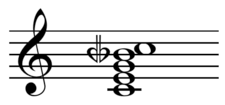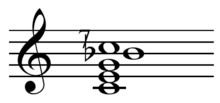Harmonic seventh chord



The harmonic seventh chord is a major triad plus the harmonic seventh interval (ratio of 7:4, about 968.826 cents[1]). This interval is somewhat narrower (about 48.77 cents, a septimal quarter tone) and is "sweeter in quality" than an "ordinary"[2] minor seventh, which has a just-intonation ratio of 9:5[3] (1017.596 cents), or an equal-temperament ratio of 1000 cents (25/6:1). Frequent use of this chord is one of the defining characteristics of blues and barbershop harmony; barbershoppers refer to it as "the barbershop seventh". Since barbershop music tends to be sung in just intonation, the barbershop seventh chord may be accurately termed a harmonic seventh chord. The harmonic seventh chord is also widely used in "blues flavored" music. As guitars, pianos, and other equal-temperament instruments cannot play this chord, it is frequently approximated by a dominant seventh chord. As a result, it is often called a dominant seventh chord and written with the same symbols (such as the blues progression I7 - V7 - IV7).
A frequently encountered example of the harmonic seventh chord is the last word of the "...and many more!" modern addition to the song "Happy Birthday to You" When sung by professional singers, the harmony on the word "more" typically takes the form of a harmonic seventh chord.[4]
The alpha scale has, "excellent harmonic seventh chords...using the inversion of 7/4, i.e., 8/7."[5] ![]() Play .
Play .
It is suggested that the harmonic seventh on the dominant not be used as a suspension, since this would create a mistuned fourth over the tonic.[6] The harmonic seventh of G, F![]() +, is lower than the perfect fourth over C, F♮, by Archytas' comma (27.25 cents). 22 equal temperament avoids this problem because it tempers out this comma, while still offering a reasonably good approximation of the harmonic seventh chord.
+, is lower than the perfect fourth over C, F♮, by Archytas' comma (27.25 cents). 22 equal temperament avoids this problem because it tempers out this comma, while still offering a reasonably good approximation of the harmonic seventh chord.
Barbershop seventh

barbershop seventh chord. A chord consisting of the root, third, fifth, and flatted seventh degrees of the scale. It is characteristic of barbershop arrangements. When used to lead to a chord whose root is a fifth below the root of the barbershop seventh chord, it is called a dominant seventh chord. Barbershoppers sometimes refer to this as the 'meat 'n' taters chord.' In the nineteenth and early twentieth centuries, these chords were sometimes called 'minors.' [as in minor seventh chord]"— Averill 2003[7]
The barbershop seventh is the name commonly given by practitioners of barbershop music to the seventh of and the major-minor seventh or dominant seventh chord, when it is used in a barbershop arrangement or performance. "Society arrangers believe that a song should contain anywhere from 35 to 60 percent dominant seventh chords to sound 'barbershop'--and when they do, barbershoppers speak of being in 'seventh heaven.'"[8]
Barbershop music features both major-minor seventh chords with dominant function (resolving down a perfect fifth), often in chains (secondary dominants), and nondominant major-minor seventh chords.[9]
Beginning in the 1940s, barbershop revival singers "have self-consciously tuned their dominant seventh and tonic chord in just intonation to maximize the overlap of common tones, resulting in a ringing sound rich in harmonics" called 'extended sound', 'expanded sound', 'fortified sound', "the voice of the angels".[10] The first positive mention of such practice appears to be Reagan, 'Molly' (1944). "Mechanics of Barbershop Harmony", Harmonizer. The example of a dominant chord tuned to 100, 125, 150, and 175 Hz, or the 4th, 5th, 6th, and 7th harmonics of a 25 Hz fundamental is given,[10] making the seventh of the chord a "harmonic seventh".
There's a chord in a barbershop that makes the nerve ends tingle....We might all our chord a Super-Seventh!...The notes of our chord have the exact frequency ratios 4-5-6-7. With these ratios, overtones reinforce overtones. There's a minimum of dissonance and a distinctive ringing sound. How can you detect this chord? It's easy. You can't mistake it, for the signs are clear; the overtones will ring in your ears; you'll experience a spinal shiver; bumps will stand out on your arms; you'll rise a trifle in your seat."— Art Merill[10]
It is normally voiced with the lowest note (the bass) on a root or a fifth, and its close harmony sound is one of the hallmarks of barbershop music.
When tuned in just intonation (as in barbershop singing), this chord is called a harmonic seventh chord.
Sources
- ↑ Bosanquet, Robert Holford Macdowall (1876). An elementary treatise on musical intervals and temperament, pp. 41-42. Diapason Press; Houten, The Netherlands. ISBN 90-70907-12-7.
- ↑ "On Certain Novel Aspects of Harmony", p.119. Eustace J. Breakspeare. Proceedings of the Musical Association, 13th Sess., (1886 - 1887), pp. 113-131. Published by: Oxford University Press on behalf of the Royal Musical Association.
- ↑ "The Heritage of Greece in Music", p.89. Wilfrid Perrett. Proceedings of the Musical Association, 58th Sess., (1931 - 1932), pp. 85-103. Published by: Oxford University Press on behalf of the Royal Musical Association.
- ↑ Mathieu, W.A. Harmonic Experience. Inner Traditions International; Rochester, Vermont; 1997. ISBN 0-89281-560-4, pg. 126
- ↑ Carlos, Wendy (1989–96). "Three Asymmetric Divisions of the Octave", WendyCarlos.com.
- ↑ Robert Halford, Macdowall Bosanquet, Rudolf Rasch (1876). An elementary treatise on musical intervals and temperament, p.42.
- ↑ Averill, Gage (2003). Four Parts, No Waiting: a Social History of American Barbershop Harmony, p.205. ISBN 0-19-511672-0.
- ↑ Averill (2003), p.163.
- ↑ McNeil, W. K. (2005). Encyclopedia Of American Gospel Music, p.26. ISBN 9780415941792.
- 1 2 3 Averill (2003), p.164.